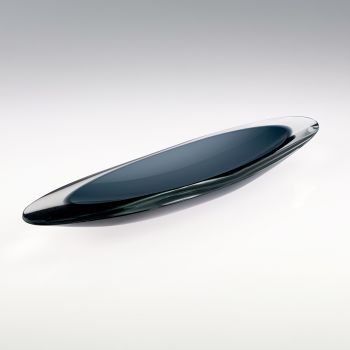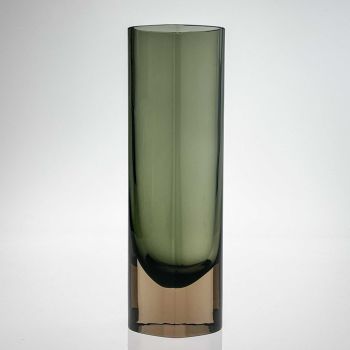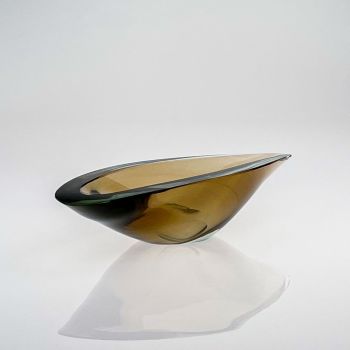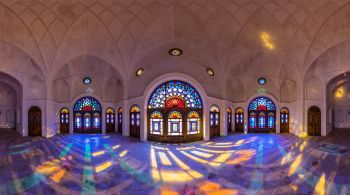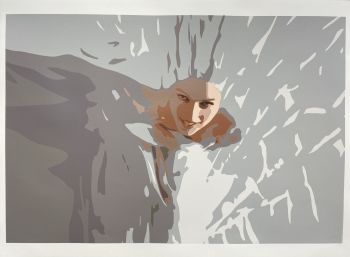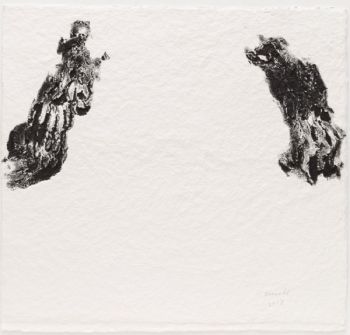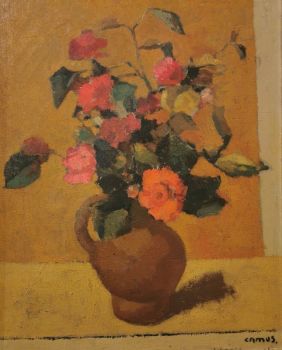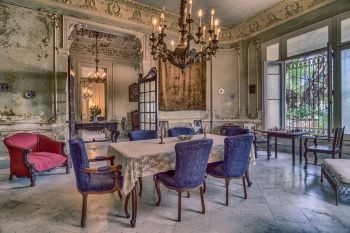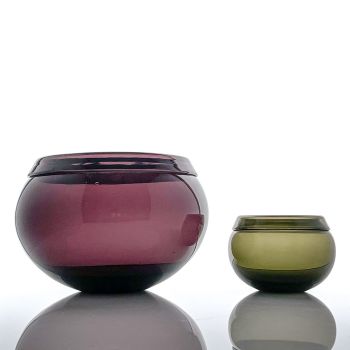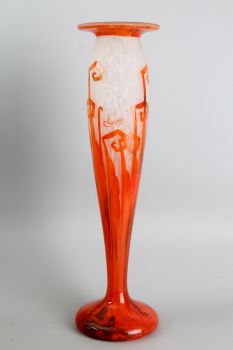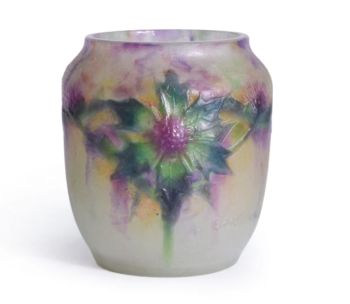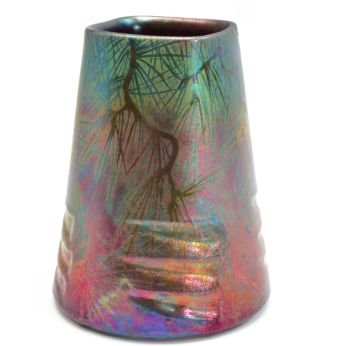A blue and clear glass art-object "Lansetti" (Lancet), model KF218 - Nuutajärvi-Notsjö, Finland 1963 1963
Kaj Franck
Bicchiere
10 ⨯ 33 ⨯ 8 cm
ConditionVery good
Attualmente non disponibile tramite Gallerease
- A proposito di opere d'arteA free blown and cut and polished blue and clear cased artglass object "Lansetti"(Lancet), model KF218. Designed by Kaj Franck in 1953 and executed by the Nuutajärvi-Notsjö glassworks in 1963.
These rare objects were made between 1953-and 1966 in two different sizes and different colour combinations. This being a smaller sized blue and clear glass example made in 1963.
This art object is in very good vintage condition. It is fully signed and dated in diamondpen underneath the base: K. Franck Nuutajärvi-Notsjö '63.
Condition
This "Lansetti" is in very good vintage condition. Some minor scratches and wear consistent with age and use. No chips or cracks.
Literature
Marianne Aav (ed.), Kaj Franck, Universal Forms, p. 248 (illustrated), p.323
About Kaj Franck
Kaj Franck (Vyborg, Finland 1911 – Santorini, Greece 1989) was an influential Finnish designer and leading figure in Finnish art-world between 1940-1980. Today his name is used for the prestigious “The Kaj Franck Design Prize” annually awarded by the Finnish Design Forum.
Born in 1911 on the Finnish-Russian border in a family of architects (his grandfather was director of the famous Arabia Ceramics factory) of Finnish-German-Swedish decent.
He attended the furniture department of Taideteollinen korkeakoulu (todays Aalto university school of Arts, Design and Architecture) in Helsinki.
After his studies he worked as a freelance designer until he joined Arabia as a designer in 1945. In 1950 he became Arabia’s Artistic Director. He also designed glass-objects for Iittala between 1946 and 1950 and between 1950 and 1976 for Nuutajärvi-Notsjö glassworks.
From 1945 onwards he worked as and educator at Taideteollinen korkeakoulu and he became the institute's Artistic Director in 1960.
His modernist designs in everyday tableware glass are considered to be a revolution and classic Finnish design object (most notably his Kilta tableware and Kartio glassware).
He is often referred to as “the conscience of Finnish design”, moderation, ecology and equality were Franck’s principles. He strove to minimise the number of everyday objects we need in our lives, drawing attention to the sustainability and life cycle of products.
Kaj Franck’s designs are in collections of numerous museums all over the world. Among others: Design Museum Helsinki, Museum of Modern Art, New York, Stedelijk Museum Amsterdam and The British Museum, London. He was a recipient of many prizes. Most notably the Lunning prize in 1955, a “Grand prix” and several “Gold medals” at the Triennale di Milano. - A proposito di opere artista
Il designer finlandese di ceramica e vetro Kaj Franck (1911-1989) ha realizzato una potente verità nella sua illustre carriera: semplice è bello. Nonostante il mondo si muova a un ritmo sempre più veloce, da un decennio all'altro, quella semplice verità rimane. L'ispirazione ei principi di Franck hanno dato inizio a una tradizione nel design finlandese, che è ancora viva e forte oggi. Le sue opere più note sono Iittala Teema e la serie Kartio, e la sua eredità fa parte di ogni casa finlandese.
"Voglio fare uso di oggetti che sono così ovvi da non essere evidenti", Kaj Franck ha definito il proprio lavoro. I suoi progetti soddisfacevano i bisogni umani di base mentre servivano loro strumenti con proprietà di oggetti di uso quotidiano. Franck era anche interessato a basso- costò la produzione di massa e rifiutò il materialismo, la cultura dell'usa e getta e l'ostentazione. Il mondo di Franck consisteva nelle forme matematiche di base e nelle forme semplici, decorate solo con colori forti.
Il punto di partenza del lavoro di Franck era la praticità unita alla bellezza. Anche se oggi sembra ovvio, ai suoi tempi i suoi pensieri erano radicali. Franck ha separato gli stili e le tendenze della moda dalla tradizione e gli ha dato un significato completamente nuovo. Nel periodo 1952-53, Franck ha dimostrato che le stoviglie non devono essere eccessivamente complesse con l'uscita della serie Kilta come affermazione forte: era un'idea nuova che ognuno fosse in grado di apparecchiare la tavola secondo le proprie esigenze .
Franck ha iniziato i suoi progetti concentrandosi sull'idea o sul concetto sottostante, non sulla forma. Questa enfasi sull'aspetto ideativo del design è stata trasferita anche al suo lavoro come insegnante e successivamente come direttore artistico presso l'Università di Arte e Design di Helsinki. Franck è stato anche uno dei primi sostenitori del riciclaggio ed è stato spesso definito la "coscienza del design finlandese". Franck ha vinto numerosi premi nella sua illustre carriera ed è diventato famoso a livello internazionale. Oggi, il Kaj Franck Award è il riconoscimento di design più prestigioso della Finlandia .
Artwork details
Related artworks
- 1 - 4 / 10
- 1 - 4 / 24
Frères Daum
Daum Nancy – “Paysage Soleil Couchant” vase with two applied handles1900 - 1910
Prijs op aanvraagAntiques Emporium
Gabriel Argy-Rousseau
Gabriël Argy-Rousseau – Crabes et Algues vase – 19201920 - 1929
Prijs op aanvraagAntiques Emporium
1 - 4 / 24Onbekende Kunstenaar
Gevleugelde Venetiaanse bokaal1650 - 1700
Prijs op aanvraagPeter Korf de Gidts - Antiquairs
1 - 4 / 24








